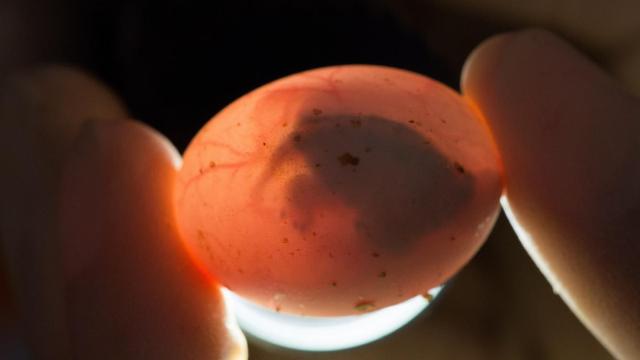Apr 16 2015
Bisphenol A (BPA) is a chemical that is used in a variety of consumer products, such as food storage products and resins that line plastic food and beverage containers. Often, aquatic environments such as rivers and streams become reservoirs for BPA, and fish and turtle habitats are affected. Now, a collaboration of researchers from the University of Missouri, Westminster College, the U.S. Geological Survey and the Saint Louis Zoo have determined that BPA--which mimics estrogen--can alter a turtle's reproductive system and disrupts sexual differentiation. Scientists are concerned findings could indicate harmful effects on environmental and human health.
 Scientists found that BPA can alter a turtle's reproductive system and disrupts sexual differentiation while it develops in the egg. Researchers are concerned findings could indicate harmful effects on the environment and to human health. Credit: Roger Meissen, Bond Life Sciences Center
Scientists found that BPA can alter a turtle's reproductive system and disrupts sexual differentiation while it develops in the egg. Researchers are concerned findings could indicate harmful effects on the environment and to human health. Credit: Roger Meissen, Bond Life Sciences Center
"Normally, the painted turtle's sex is determined by the temperature of the environment during their development in the egg--cooler temperatures yield more male turtles, while warmer temperatures mean females are more likely to develop," said Dawn Holliday, adjunct assistant professor of pathology and anatomical sciences in the MU School of Medicine and assistant professor of biology at Westminster College in Fulton, Mo. "However, when turtle eggs are exposed to environmental estrogens, their sex is no longer determined by the temperature, but rather by the chemical to which they're exposed."
Researchers applied a liquid form of BPA on hundreds of painted turtle eggs that were then exposed to cooler temperatures, comparable to those needed to produce male turtles. Then, the scientists examined the turtles' sex organs to determine the effects of BPA on their development. They found that the male turtles had developed sex organs with features typically found in females.
"We already know the genetic marker where the temperature-dependent sex determination occurs, which provides us a good indication of where the endocrine disruption is taking place," said Sharon Deem, director of the Saint Louis Zoo Institute for Conservation Medicine and a lead investigator on the study. "Our findings show that BPA essentially overrides the temperature in determining the sex of the turtle, creating turtles that are probably unable to reproduce."
For the study, scientists mimicked the levels of BPA found in samples from waterways. Turtles are known as an "indicator species" because they can be used as a gauge for the health of the entire ecosystem. By understanding the possible effects chemicals have on turtles, researchers might be able to understand the possible effects the chemicals have on other species, even humans, Holliday said.
"The doses we tested are environmentally relevant," said Cheryl Rosenfeld, associate professor of biomedical sciences in the MU College of Veterinary Medicine, a researcher in the MU Bond Life Sciences Center and a co-author of the study. "If BPA has negative impacts on turtles, then it most likely has implications for human health as well."
The scientists suggest further examination to determine the underlying mechanisms of sex reversal in reptiles and how these translate to endocrine-disrupting chemical exposure in wild populations. Fred vom Saal, Curators Professor of Biological Sciences in the College of Arts and Science at MU, Don Tillitt, an adjunct professor of biological sciences at MU and a research toxicologist with the USGS, and Ramji Bhandari, an assistant research professor of biological sciences at MU and a visiting scientist with the USGS, all collaborated on the study.
"Developmental exposure to bisphenol A (BPA) alters sexual differentiation in painted turtles (Chrysemys picta)," recently was published in the journal, General and Comparative Endocrinology. Funding was provided by Mizzou Advantage, an MU initiative that fosters interdisciplinary collaboration among faculty, staff, students and external partners to solve real-world problems in four areas of strength identified at the University of Missouri. These areas include Food for the Future, Sustainable Energy, Media for the Future and One Health/One Medicine.